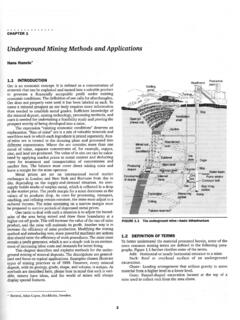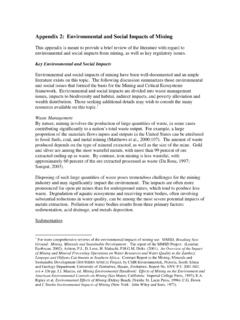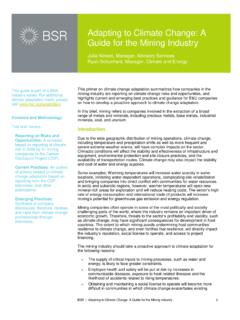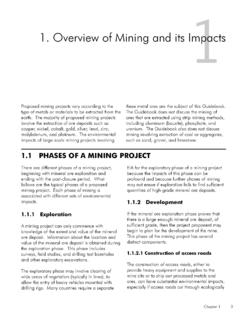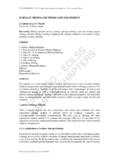Transcription of HEAP LEACHING TECHNIQUE in MINING
1 HEAP LEACHING TECHNIQUE in MINING Within the Context of BEST AVAILABLE TECHNIQUES (BAT) Caner Zanbak, PhD Supported by Euromines The European Association of MINING Industries, Metal Ores & Industrial Minerals November, 2012 Introductory Statement by Euromines The objective of MINING is to provide valuable minerals needed by the society. For doing so, MINING companies extract resources from mineral deposits around the globe and use different techniques to recover the valuable mineral resources from the ore. The choice of a suitable TECHNIQUE , which is both environmentally sound and economically viable, to process mineral resources very much depends on the type of ore which is mined as well as of the physical conditions linked to the location of the mine site.
2 Heap LEACHING is a tried and tested MINING TECHNIQUE enabling the processing of different kinds of ores which could not otherwise be exploited under viable economic conditions. Modern day heap LEACHING , which has a relatively low level of energy consumption, is for example successfully used for the beneficiation of certain types of gold ores in Turkey . It contributes to the substantial development of a sustainable gold MINING sector in that country and has the potential to help fostering sustainable supply of raw materials in other countries within Europe. This document, prepared by the Turkish Gold Miners Association and supported by Euromines, has benefited from the contributions of Euromines Members as well as of experts from several MINING companies, both within Europe and abroad.
3 It aims at: (i) presenting an up to date overview of modern day heap LEACHING in MINING ; (ii) providing the relevant information to consider heap LEACHING in the context of Best Available Techniques (BAT) as defined by the relevant regulatory instruments of the European Union. In this respect, the author would like to express his particular gratitude to the following experts for their valuable contribution to the present work: - David A. Bickford, General Manager and Chairman of T prag Metal MINING , Turkey - Anthony Crews, Vice President & Principal, The Mines Group, Reno, Nevada, USA - Miguel Diaz, Technical Director, AMEC Earth & Environmental, UK - Larry Enloe, Manager, N. American Regional Business Unit, Barrick Gold, Utah, USA.
4 - Louise Grondin, Senior VP, Agnico-Eagle, Sweden - Corina Hebestreit, Director, Euromines, Brussels - Robert Rose, CEO, Andina Minerals, Toronto, Ontaria, Canada (formerly KCA, Reno, Nevada) - Marja Riekkola-Vanhanen, Sr. Biotechnology Advisor, Talvivaara Nickel Mine, Finland i HEAP LEACHING TECHNIQUE in MINING Within the Context of BEST AVAILABLE TECHNIQUES (BAT) TABLE OF CONTENTS 1. 1 2. ORE BENEFICIATION METHODS IN MINING .. 3 3. LEACHING IN THE NATURAL ENVIRONMENT .. 5 4. LEACHING LIXIVIANTS USED IN MINING .. 6 5. BASIC EFFICIENCY FACTORS IN HEAP LEACH PROCESS .. 6 6. LEACHING TECHNIQUES USED IN MINING .. 9 Historical Leach MINING .. 10 Modern Day Leach MINING .. 10 7. DESIGN COMPONENTS OF A HEAP LEACH UNIT.
5 13 Agglomeration .. 13 Leach Pads .. 14 Leach Pad Bottom - Ground Surface .. 15 Leach Pad Liner System .. 16 Ponds Solution Management .. 17 Ore Heap .. 19 Lixiviant Solution Application and Pregnant Solution Collection .. 20 Ore Stacking .. 21 Heap Rinsing and Pad Closure .. 22 Stability Assessment of Heap Leach Pads .. 22 Geotechnical Site Investigations and Material Testing: .. 23 Stability of Leach Piles: .. 24 8. REGULATORY DEFINITION OF BEST AVAILABLE TECHNIQUES .. 25 Annex IV of the Directive 2008/1/EC: .. 25 BREF on Management of Tailings and Waste-Rock in MINING Activities .. 26 Framework Concept for Evaluation of a TECHNIQUE in Consideration as a BAT .. 27 9. CONCLUSIONS .. 32 10. REFERENCES CITED.
6 33 1 HEAP LEACHING TECHNIQUE in MINING Within the Context of BEST AVAILABLE TECHNIQUES (BAT) 1. INTRODUCTION The objective of the Directive 2006/21/EC on the management of waste from extractive industries and amending Directive 2004/35/EC (the MINING Waste Directive) is to prevent or reduce as far as possible any adverse effects on the environment or on human health which are brought about as a result of the management of waste from the extractive industries. Accordingly, the MINING Waste Directive covers the management of waste from land-based extractive industries, that is to say, the waste arising from the prospecting, extraction, treatment and storage of mineral resources and from the working of quarries.
7 It requires that measures taken to achieve its objective are based inter alia on Best Available Techniques (BATs), as defined by Directive 96/61/EC of 24 September 1996 concerning integrated pollution prevention and control (IPPC), which has been codified by Directive 2008/1/EC. Directive 2008/1/EC of 15 January 2008 concerning integrated pollution prevention and control (the IPPC Directive), whose objective is to prevent or reduce emissions in the air, provides a detailed definition of best available techniques . Directive 2008/1/EC will be repealed in January 2014 by Directive 2010/75/EU of 24 November 2010 on industrial emissions which provides for a similar definition of best available techniques.
8 The European Integrated Pollution Prevention and Control (IPPC) Bureau, established under the framework of European Commission's Joint Research Centre (JRC), is entrusted with the task to develop reference documents on Best Available Techniques, called BREFs, through an exchange of information involving the relevant stakeholders, notably the Member States and the industry. BREFs are the main reference documents used by competent authorities in Member States when issuing operating permits for installations that represent a significant pollution potential in Europe. A revised BREF document on Management of Tailings and Waste-Rock in MINING Activities was adopted in January 2009, in accordance with article 21(3) of the MINING Waste Directive.
9 It describes BAT that can be considered as examples of good practice for mineral processing, tailings and the waste-rock management of ores that have the potential for a strong environmental impact. This BREF document covers fourteen different metals, including gold, that are mined and/or processed in the European Union (EU-15), the acceding countries, the candidate countries and Turkey, Heap LEACHING techniques are briefly addressed in this version of the BREF document but not sufficiently described. The objective of this document is to provide an overall review of: LEACHING process in MINING practice, with special emphasis on available techniques applicable for Heap LEACHING of very low grade ores that are not considered economical 2 to treat with other BATs , availability of applicable technologies by global suppliers, effectiveness of technologies used in Heap LEACHING to control emissions for protection of the environmental media, and evaluation of the heap LEACHING process and available techniques within the context of regulatory BAT concept as a technical supplement to the existing BREF document.
10 Heap LEACHING is BAT for suitable ores because it allows the economical processing of ore that would otherwise be uneconomic under conditions that can technically achieve regulatory acceptable levels of environmental risk mitigation. All of the materials used in heap LEACHING process and industry specifications of materials are available globally. Also, slope stability evaluations of stacked heap leach pads are performed using standard geotechnical engineering principles and practice. Therefore, in accordance with the definition of BAT provided by the IPPC Directive and with the objectives of the MINING Waste Directive, emphasis is given to emission minimization concepts for the Heap LEACHING TECHNIQUE and design specifications for engineered materials and heap stability analysis methods are not prescribed in this document.


